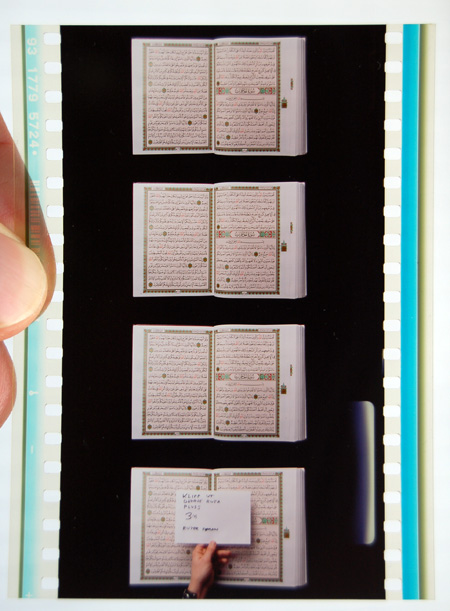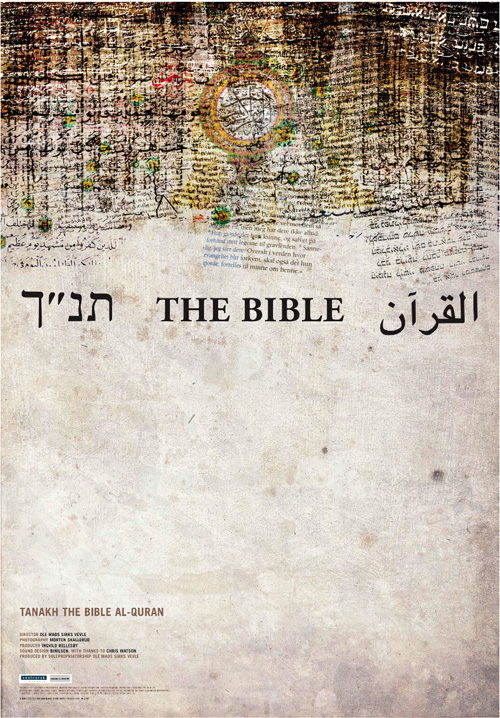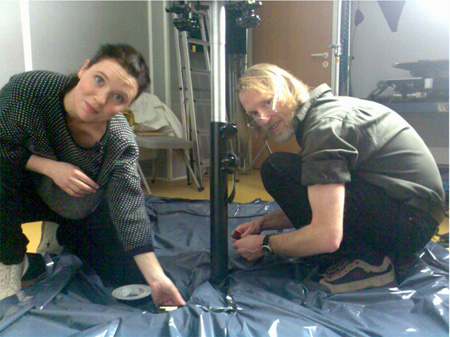"The making of" Tanakh Bibelen al-Quran
|
Read more
at in70mm.com The 70mm Newsletter |
| Written by: Ole Mads Sirks Vevle, Bergen, Norway | Date: 29.08.2008 |
 Ole Mads Sirks Vevle,
Morten Skallerud and Ingvild Hellesøy in Paris. Image by
Dominique Benichetti Ole Mads Sirks Vevle,
Morten Skallerud and Ingvild Hellesøy in Paris. Image by
Dominique BenichettiBergen, Norway, March, 1998: I was out walking in the streets. At the time I was studying media science at the University, and I was in the middle of a short film production “Portraits – act? studies of great personalities”. The sun was shining, and then suddenly the idea came to me; "What if I film every page of the Bible, and then show them very rapidly in a sequence? What will happen? Which patterns will appear? What will it look like? Will new meanings emerge, will hidden layers be revealed?" I immediately liked the idea. I liked the thought that it is possible now, in our technological age (with the advent of movie cameras) to present the Bible in this way, and that it's both a documentation (of every page) and also a totally new presentation, a radical shift of perspective. Instead of focusing on the literal meaning of the text, I would focus on the underlying structures that enable meaning to appear. Due to the long time it has taken from the earliest recordings of biblical texts up until current editions, the movie would represent a substantial compression of time. I am very textual/religious/ scripture- oriented and I wanted to put the text itself in the foreground. |
More
in 70mm reading: Morten Skallerud visits in70mm.com MCS 70 - Superpanorama The Work of Jan Jacobsen Internet link: Ole Mads Sirks Vevle Camera Magica |
A first attempt |
|
 Actual
70mm frames supplied by Ole Mads Sirks Vevle Actual
70mm frames supplied by Ole Mads Sirks VevleThe next two years I went to Nordland Art- and Filmschool, located in Kabelvåg in Lofoten, where I originally tried out the idea. I shot the “film” on an old hi-8 camera that was fixed in the ceiling, the book, a black leather bible, laying flat on a table underneath. Every double page was shot with a duration of 2 frames. The total duration was 1 minute and 20 seconds. The quality was rather bad, due to the hi-8 video, but it did get accepted at the Norwegian short film festival in Grimstad in 1999. This first version I considered as a sketch, it HAD to be done again in a much larger format.. |
|
A close call |
|
|
In 2000 I presented the idea to a production company in Bergen, Bunker
Film. They wanted to produce the film and shoot it on 35-mm. We applied
for money, but received none, so the project went dormant. |
|
And the winner is... |
|
|
Many years passed by. I established myself as a short movie maker, and
participated in several short film festivals. My breakthrough came in
2003, where I together with Flimmerfilm won two prizes at the Critic’s
Week at Cannes Film Festival with the short movie “Love is the Law”. |
|
The three faces of god |
|
 Vintage
MCS 70 camera owned by Arane Gulliver in Paris. Image by Thomas
Hauerslev Vintage
MCS 70 camera owned by Arane Gulliver in Paris. Image by Thomas
HauerslevAfter that I picked up again the idea about filming the Bible. I wanted to include the Arabic Quran and the hebrew Bible (known as the Tanakh). They have very different typography, and again, I was curious about the visual and the thematic outcome. It felt natural to portray these books together since they have a strong internal connection. The three of them are like the “children of Abraham”, sharing the idea about the one God. They belong to the same chain of revelation. Their scriptures are holy, the one building upon the other, and each one being a foundation for a world religion. |
|
One god, one movie, one revelation |
|
|
At first I thought of making them as separate films, a trilogy, but
pursuing the thought, I realised that it was best to put them together
and make one movie. At the same time as I would be portraying three
books, I also would be portraying three different cultures, three
different religions. Depending on your cultural background, you
understand one of them, but in my manner of portraying them, they would
all be “readable” by everyone. In this sense the project also had a
educational side to it, especially in our day and age, where we again
have started to fear “the other”. |
|
The time is nigh… |
|
| Bergen, January
2006: I decided to move forward with the project. First I needed a Producer.
I asked a friend of mine, Ingvild Hellesøy (newly educated from the Nordland
kunst- og filmskole). She suggested that the project should be done on 70-mm
(I had been thinking 35-mm) and that she could contact Morten Skallerud (“A
Year Along the Abandoned Road”) to do the camera and editing. Then I knew I
would have the right person for the right job. Both of her suggestions
ensured a really high quality production. Myself having background from
digital video did not have the proper 70-mm experience and knowledge. Who
better to work with than the Norwegian film pioneer Morten Skallerud? |
|
We are on a roll |
|
 Morten
Skallerud photographing the short film in Paris. Image by
Dominique Benichetti Morten
Skallerud photographing the short film in Paris. Image by
Dominique BenichettiTo our great pleasure Morten Skallerud, seeing the opportunity to work with 70mm again, did not hesitate. At the same time we contacted the West Norwegian Filmcenter and the former chief, Hans Dragesund. While presenting the idea (and not yet mentioning that the film should be shot on 70mm), he suggested that this had to be filmed on 70mm. We were extremely pleased with his reaction, because we thought that we would have problems with convincing the “money people” why it should be done on 70mm! Dragesund gave us some “seed” money to develop the project and do some test shooting, books had to be bought, etc. And we had to find a camera (there are not that many 70-mm cameras around). This found its solution through Morten Skallerud’s connections. He had been working with Gulliver laboratory in Paris and he knew that they had a 70mm camera, to be precise a MCS 70. Ingvild Hellesøy contacted them and they were happy that somebody wanted to use it, and it helped a lot when they heard it was Morten Skallerud that was going to handle the camera. So deals were made about us coming there early spring in 2007 and shoot the film there. At this point we also had received funding from Norsk filmfond. Later “Fond for Lyd og Bilde” also chipped in some money. |
|
Going to Paris |
|
| Paris, February
2007: The three of us, Ingvild Hellesøy, Morten Skallerud and myself, came
to Gulliver Laboratory in the evening of Sunday, 4 February. It was a great
advantage to shoot the film inside the facilities of a top quality
laboratory. This meant that we did not lose time in having to send the films
to and fro. Instead we were able to do some test shooting while being on the
set, get the film developed in a couple of hours, and make our changes. This
way we luckily discovered early on a slight light leakage (this was fixed
with a home-made shutter device), and we were able to do some other slight,
but necessary corrections. In addition the camera was already in its rig,
facing straight down, perfect for our intention. |
|
And it was evening, and it was morning… |
|
 The
Poster The
PosterDay 1: We had to make a wooden frame on the floor and fill it with soil, the thought was to have a black, or dark, background for the books, and Ingvild had the idea about using soil. So we bought soil, made the frame, looked at the books, planned the shootings, had a closer look at the camera, set up the lights, and we also did some test shooting. Day 2: We started shooting, first out was the Quran. This was the widest and the “thinnest” book with its 620 pages, and also the most difficult. This had to do with the binding, the pages wouldn't always lie still, but after working with it, we worked our way through all the pages. At the same time this book was the most colourful, and the one that was most different from our cultural perspective. The pages were turned from right to left. Images shot: 620 pages (310 double pages x 3 shots) = 930 images Day 3: We shot the Tanakh. This was the thickest and heaviest book, consisting of 1308 pages. It was also read from right to left. This book was the most simplistic and archaic. Images shot: 1308 pages (654 double pages x 3 shots) = 1962 images Day 4: We shot the Bible, a Norwegian version, the main point being that it had Latin letters. This was the book with the most pages, 1400 to be exact, but at the same time the book that was the easiest to work with. A black bible with leather bindings, the pages lying very still, nice and easy, everything being very orderly and neat, divided into numbered chapters and paragraphs. Images shot: 1400 pages (700 double pages x 3 shots) = 2100 images Day 5: We shot the soil in the wooden frame. These images were to be inserted before and after the books, instead of titles and credits. The thought was to film something dark, but not something that was pitch black, I wanted a tangible darkness. How we were going to accomplish this was the one detail that was the most discussed in advance of the shooting process. This day Ingvild bought some champagne and French cakes, and invited all the staff of Gulliver to have a small celebration, and also thanking them for being so kind and helpful to us. Day 6: We packed our stuff together and also had a look at what we had been shooting the previous days. This was done in the theatre at Gulliver. Morten was the one who edited the different parts together. It was quite overwhelming to watch the result. It is so much information, so much text, and patterns appearing and disappearing. The watcher really has to be active and involved. Everything is in focus. If you don’t pay attention, the whole movie will pass you by. So you have to decide how to watch, where to focus. But, yes, I was very overwhelmed, relieved and excited about the whole process. Day 7: We rested. |
|
One-two-three one-two-three one-two-three |
|
 Image
supplied by Ole Mads Sirks Vevle Image
supplied by Ole Mads Sirks VevleA closer look at the shooting process: I was in charge of turning the pages, and Morten Skallerud, who was in charge of the camera, pressed the shooting button connected to the camera. Every double-page was shot three times, that is to say, three frames. Before he pressed the button I had to step in and out of the frame. First I stepped into the frame, just beneath the camera. The book that was about to be shot, lay nicely on an especially designed adjustable pedestal, designed by the technological wizard Dominique Benichetti. I turned the page, then I took three steps backward. Morten pulled the string attached to the shutter device, pressed the button one-two-three times, and then released the string, putting the shutter back to its place. I took three steps forward, turned the page, three steps backward. Morten pulling the string, pressing the button one-two-three times, releasing the string, me taking three steps forward, and so on. This was the best part of the whole process. We enjoyed the solemnity of this process. While we were in the studio shooting, Ingvild was making sure no one entered the room, fixed us lunch and did all sorts of expected and unexpected work. She was our connection to the outer world. |
|
First we take Paris then Stockholm |
|
 Ingvild Hellesøy
and Morten Skallerud. Image by Ole Mads Sirks Vevle Ingvild Hellesøy
and Morten Skallerud. Image by Ole Mads Sirks VevleAfter Paris, I went to Stockholm to work together with the Swedish sound artist B J Nilsen. We had already been in contact for a year. We came in contact with him through Touch Music, (a year earlier Ingvild and I went to London and had a meeting with Mike Harding the director of Touch Music). We wanted the soundtrack to consist of field recordings. And B J Nilsen had for some time been collaborating together with Chris Watson who is regarded as a master of field recording. He has been working on many BBC productions as a field recordist together with Sir David Attenbourough, and he is one of the artists signed with Touch Music. BJ Nilsen was to put together his own sounds and the sound of Chris Watson; the sound of ice glaciers breaking, wind blowing, lions roaring, doves flying, thunder and lightning, all very organic, and all very analog. B J Nilsen put together the soundtrack. The challenge as we talked about, was not to make it too overwhelming and not too subtle. We wanted the sounds to take the listener up, but not too far up, at the same time, bringing the listener down to the ground, but not too far to the ground. And of course, making it work together with the images. |
|
And then... |
|
| Finally, in May 2007, after
sound had been added, the colours corrected, and copies copied, 3000 years
after the first recordings of the biblical scriptures, the film was
completely finished, and I was standing with a new film “scroll” in my
hands. |
|
|
Go: back
- top - back issues
- news index Updated 22-01-25 |
|
